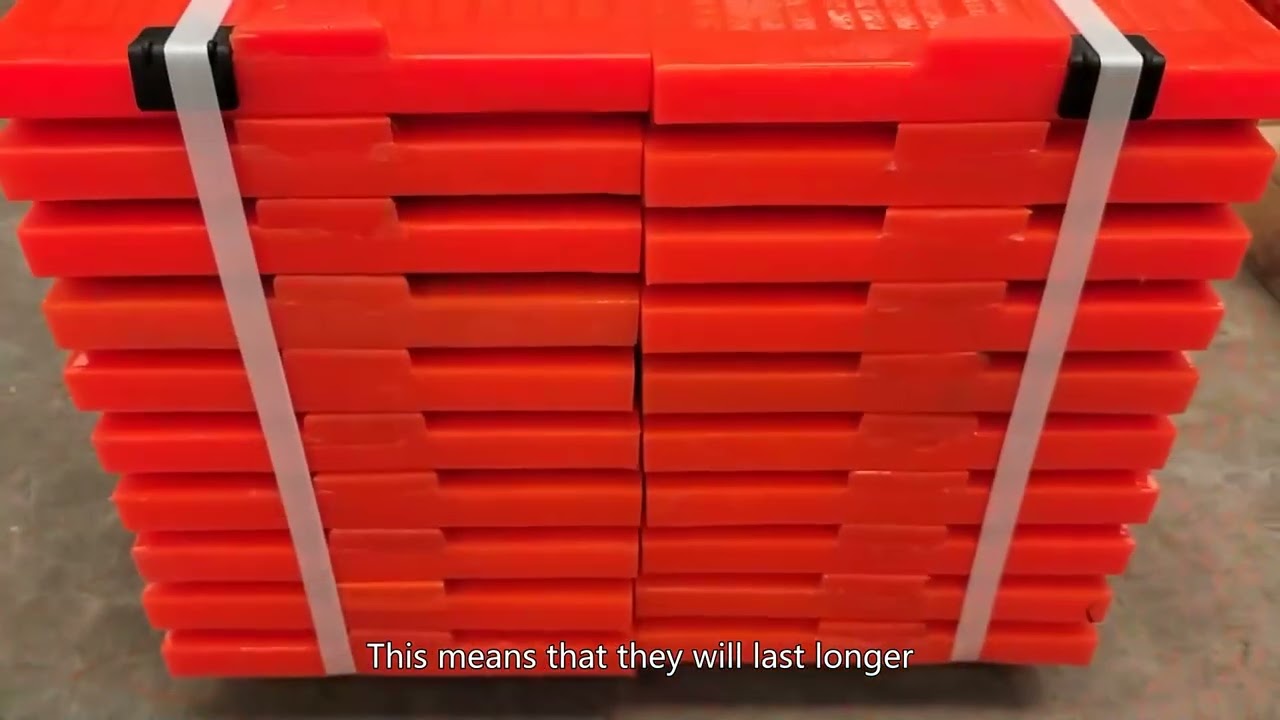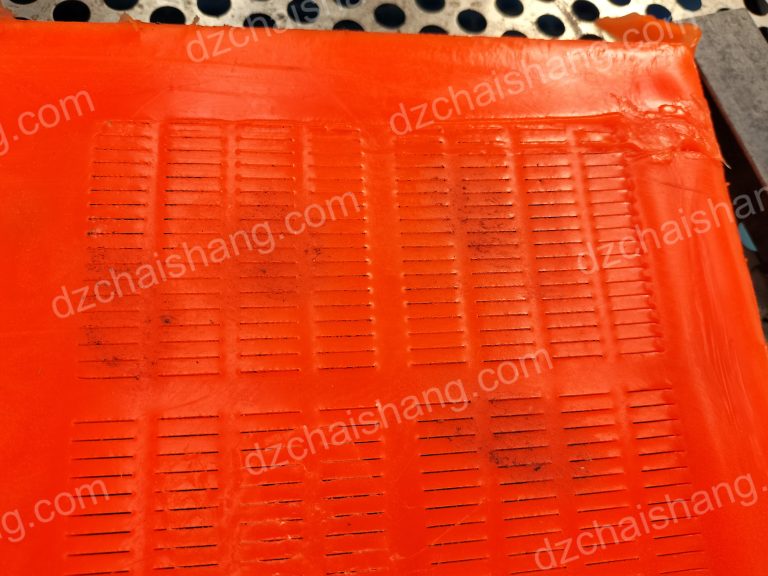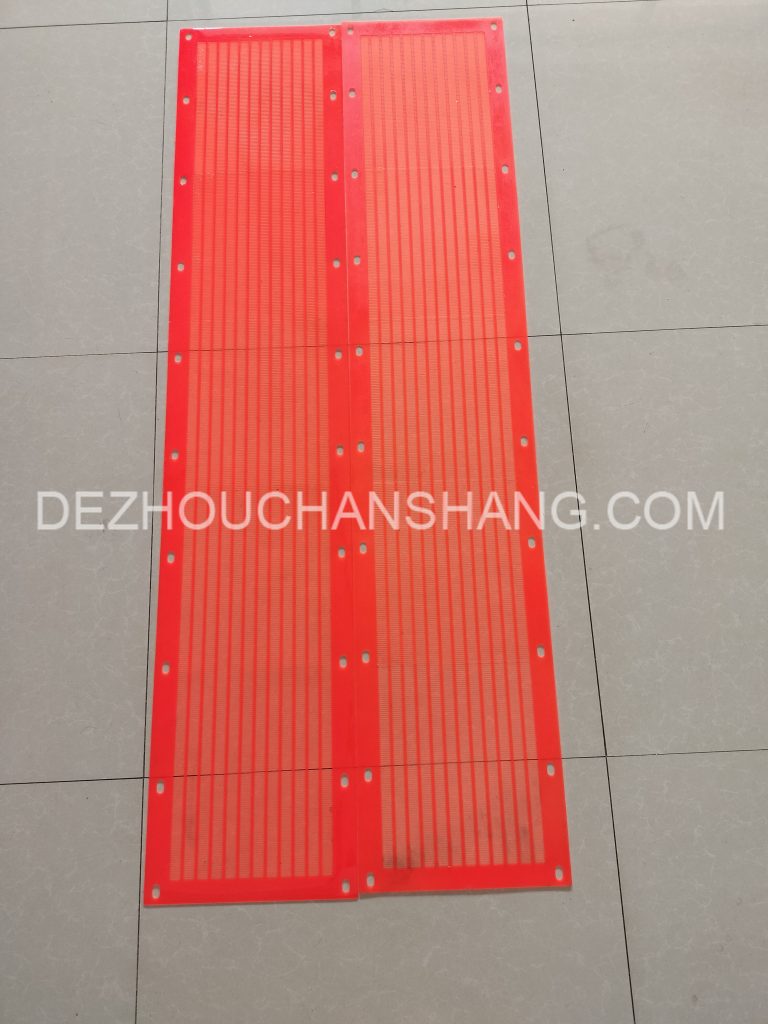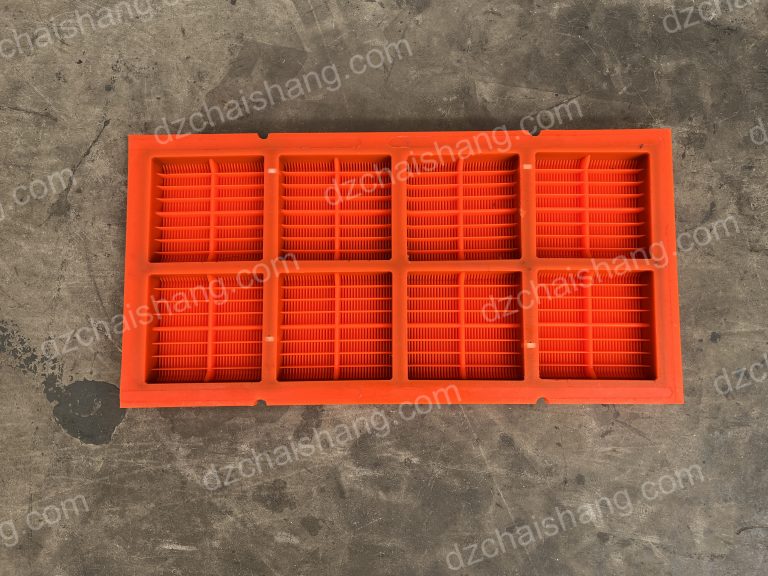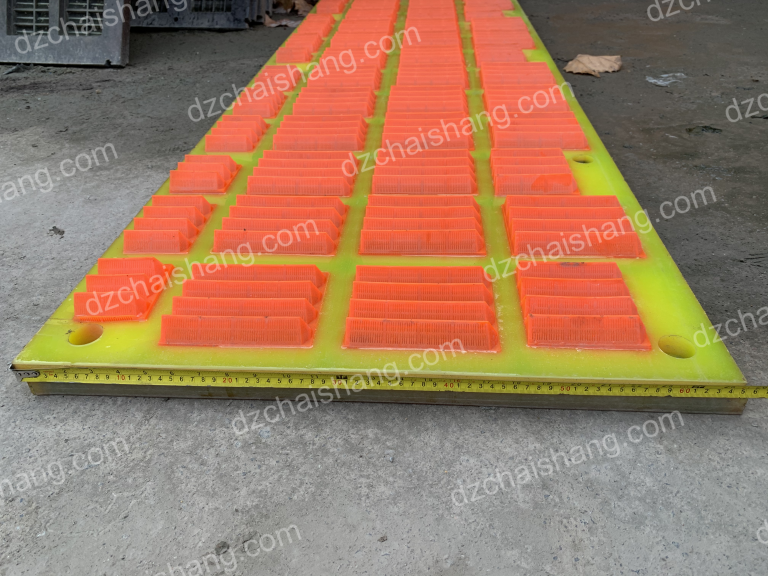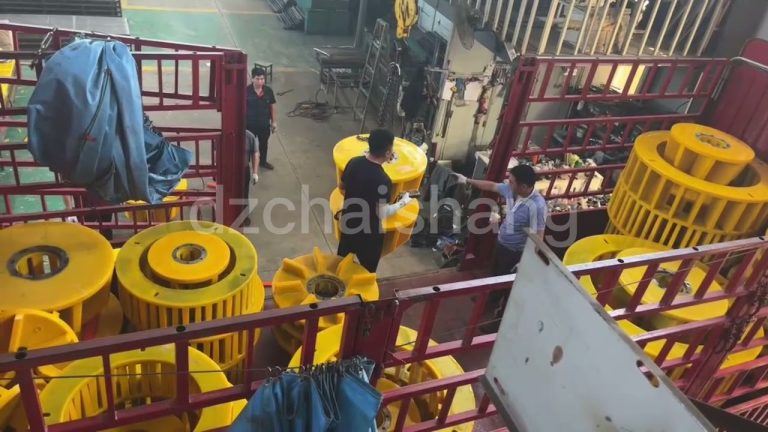Maille de tamis en polyuréthane de déshydratation à haute fréquence pour machines à tamis vibrant
Avantages de la maille de tamis en polyuréthane de déshydratation à haute fréquence dans le traitement des minéraux De plus, la résilience…
Avantages de la maille de tamis en polyuréthane de déshydratation à haute fréquence dans le traitement des minéraux
De plus, la résilience du polyuréthane permet la production d’ouvertures plus fines et plus précises, qui sont cruciales pour obtenir une séparation des particules de haute qualité. Cette précision est particulièrement importante dans le traitement des minéraux fins, où un calibrage précis peut avoir un impact significatif sur la valeur des matériaux extraits. La capacité à maintenir des tailles d’ouverture constantes, même sous des vibrations et des pressions intenses, garantit que le processus de séparation est non seulement efficace mais également rentable, car il minimise la perte de minéraux précieux.
Un autre avantage significatif du tamis en polyuréthane de déshydratation à haute fréquence réside dans ses performances de déshydratation supérieures. La conception unique du maillage facilite un drainage plus rapide de l’eau, ce qui est essentiel dans le processus de déshydratation. Une déshydratation efficace réduit la teneur en humidité du produit final, ce qui est bénéfique à la fois pour la manipulation et le traitement ultérieur des minéraux. Ceci est particulièrement vital dans les environnements où la conservation de l’eau est une priorité, car la teneur réduite en humidité diminue le besoin de processus de séchage supplémentaires, économisant ainsi de l’énergie et réduisant les coûts d’exploitation.
Conseils d’installation et d’entretien pour les tamis en polyuréthane dans les machines à tamis vibrant

Le tamis en polyuréthane de déshydratation à haute fréquence est un composant essentiel des machines modernes à tamis vibrant, particulièrement apprécié pour ses hautes performances dans les processus de séparation. L’utilisation de ce type de tamis optimise non seulement l’efficacité du tamisage, mais réduit également considérablement la teneur en eau des matériaux traités. Comprendre les procédures d’installation et de maintenance correctes est crucial pour maximiser la durée de vie et l’efficacité du tamis en polyuréthane.
Pour commencer, l’installation du tamis en polyuréthane sur les machines à tamis vibrant doit être effectuée avec précision. Dans un premier temps, assurez-vous que le cadre ou le pont du crible est propre et exempt de tout débris ou particules résiduelles provenant des opérations précédentes. Toute présence de corps étrangers peut affecter l’assise du treillis et potentiellement conduire à une usure ou à des dommages prématurés. Il est conseillé d’inspecter le cadre pour détecter tout signe d’usure ou de dommage, tel que des fissures ou des déformations, qui pourraient compromettre l’intégrité de l’installation du grillage.
Une fois la phase de préparation terminée, le grillage peut être installé. Commencez par aligner correctement le treillis avec le cadre, en vous assurant qu’il est tendu uniformément sur tous les côtés. Une tension inégale peut entraîner des problèmes tels qu’un aveuglement et une efficacité de dépistage réduite. La plupart des tamis en polyuréthane sont conçus avec des exigences de tension spécifiques, il est donc important de suivre attentivement les directives du fabricant. De plus, il est essentiel de bien fixer le treillis ; cela peut impliquer l’utilisation de types spécifiques de fixations ou de systèmes de serrage conçus pour maintenir le treillis en place sans l’endommager.
Passant de l’installation à la maintenance, des contrôles et un entretien réguliers sont impératifs pour maintenir l’efficacité opérationnelle du treillis en polyuréthane. L’une des premières tâches de maintenance consiste à inspecter régulièrement le treillis pour déceler tout signe d’usure. Recherchez des indications telles qu’un étirement, des trous ou des déchirures dans le maillage. La détection précoce de ces problèmes peut éviter des problèmes plus importants, tels qu’une fuite de matériau ou des dommages supplémentaires au cadre du tamis.
Le nettoyage du tamis en polyuréthane est une autre tâche de maintenance critique. Au fil du temps, des particules peuvent se loger dans les ouvertures des mailles, entraînant une efficacité réduite et des dommages potentiels. Le nettoyage doit être effectué en douceur pour éviter d’endommager la structure du treillis. Une brosse douce ou un jet d’air à basse pression peuvent être efficaces pour éliminer les particules piégées. Pour les résidus plus tenaces, les fabricants peuvent recommander des produits de nettoyage spécifiques qui peuvent être utilisés en toute sécurité sur le polyuréthane.
De plus, les facteurs environnementaux doivent également être pris en compte dans le programme d’entretien. L’exposition à des températures extrêmes, par exemple, peut affecter la flexibilité et la durabilité du polyuréthane. Dans les environnements où les fluctuations de température sont fréquentes, des inspections plus fréquentes peuvent être nécessaires pour évaluer l’impact sur le treillis.
Enfin, il est crucial de respecter un plan de maintenance programmé. Ce plan doit inclure des enregistrements détaillés des inspections, du nettoyage et de toute réparation ou remplacement. De tels enregistrements aident non seulement à maintenir le tamis dans un état optimal, mais également à prévoir quand des remplacements pourraient être nécessaires, évitant ainsi des temps d’arrêt opérationnels inattendus.
En conclusion, bien que le tamis en polyuréthane de déshydratation à haute fréquence offre des performances supérieures dans les machines à tamis vibrant, son la longévité et l’efficacité dépendent fortement d’une installation appropriée et d’un entretien assidu. En adhérant à ces directives, les opérateurs peuvent garantir des opérations continues, efficaces et rentables dans leurs processus de contrôle.
Comparaison des mailles de tamis en polyuréthane avec d’autres matériaux dans les applications de déshydratation
Les mailles de tamis en polyuréthane de déshydratation à haute fréquence deviennent de plus en plus le matériau de choix pour les machines à tamis vibrant, en particulier dans les applications où une élimination efficace de l’eau et une séparation des particules fines sont essentielles. Cette préférence est en grande partie due aux propriétés uniques du polyuréthane, qui offrent des avantages significatifs par rapport aux matériaux traditionnels comme le treillis métallique ou le caoutchouc.
Le treillis métallique en polyuréthane est réputé pour sa durabilité et sa résistance exceptionnelles à l’usure. Ce matériau synthétique est très flexible mais résistant, ce qui le rend résistant aux abrasions, aux coupures et aux déchirures. Cette durabilité est cruciale dans les applications de déshydratation où le tamis est soumis à des vibrations et à un impact continu sur les matériaux. Contrairement aux treillis métalliques, qui peuvent souffrir d’une usure rapide conduisant à des remplacements fréquents, les tamis en polyuréthane peuvent durer beaucoup plus longtemps, réduisant ainsi les temps d’arrêt et les coûts de maintenance.
Un autre avantage significatif du tamis en polyuréthane est son efficacité dans la séparation des particules fines. Le moulage de précision du polyuréthane permet la production d’ouvertures de tamis très fines, qui peuvent être méticuleusement adaptées aux exigences spécifiques de déshydratation. Il s’agit d’une fonctionnalité essentielle dans des applications telles que le traitement des minéraux et la déshydratation du sable, où la capture des particules fines est essentielle pour la qualité du produit et l’efficacité du processus. En revanche, les tamis en treillis métallique ont souvent du mal à filtrer les particules fines, car les fils rigides peuvent laisser des espaces plus grands et sont sujets au colmatage.
De plus, l’élasticité du polyuréthane facilite un meilleur transfert de vibrations à travers le tamis, améliorant ainsi le processus de déshydratation. Cette élasticité aide à faire rebondir les particules, à réduire le colmatage et à améliorer l’efficacité globale du processus de criblage. Les écrans en caoutchouc, bien qu’ils soient également flexibles, n’atteignent généralement pas le niveau d’élasticité du polyuréthane, ce qui peut avoir un impact sur leur efficacité de filtrage au fil du temps.
La gestion de l’eau est un autre domaine dans lequel les écrans en polyuréthane excellent. Les propriétés non mouillantes du polyuréthane réduisent la rétention d’eau à la surface du tamis, améliorant ainsi l’élimination de l’eau pendant le processus de tamisage. Cette fonctionnalité est particulièrement bénéfique dans les applications de déshydratation où une teneur plus élevée en humidité dans le produit final peut être préjudiciable. Les matériaux comme le caoutchouc, bien que quelque peu efficaces dans les applications de déshydratation, retiennent souvent plus d’humidité que le polyuréthane, ce qui entraîne une élimination de l’eau moins efficace.
De plus, la nature légère du polyuréthane par rapport aux tamis métalliques contribue à réduire la consommation d’énergie dans les machines à tamis vibrant. Le poids réduit permet des réglages de vibration moins énergivores tout en maintenant, voire en améliorant les performances de criblage. Cela contribue non seulement à réduire les coûts opérationnels, mais contribue également à l’aspect environnemental de l’opération de criblage en réduisant la consommation d’énergie.
En conclusion, lorsque l’on compare le tamis en polyuréthane avec d’autres matériaux tels que le treillis métallique ou le caoutchouc dans les applications de déshydratation, il est clair que le polyuréthane offre une durabilité supérieure, une efficacité dans la séparation des particules fines, une meilleure gestion de l’eau et une efficacité énergétique. Ces avantages en font un choix particulièrement adapté aux industries qui s’appuient sur des processus de déshydratation efficaces et efficients. À mesure que la technologie progresse et que la demande de matériaux plus durables et plus rentables augmente, le polyuréthane est appelé à devenir encore plus répandu dans les applications de déshydratation dans diverses industries.
Comparison Of polyurethane screen mesh With Other Materials In Dewatering Applications
high frequency dewatering polyurethane screen mesh is increasingly becoming the material of choice for vibrating screen machines, particularly in applications where efficient water removal and fine particle separation are critical. This preference is largely due to the unique properties of polyurethane, which offer significant advantages over traditional materials like wire mesh or rubber.
Polyurethane screen mesh is renowned for its exceptional durability and resistance to wear and tear. This synthetic material is highly flexible yet tough, making it resistant to abrasions, cuts, and tears. This durability is crucial in dewatering applications where the screen is subjected to continuous vibration and material impact. Unlike wire mesh, which can suffer from rapid wear and tear leading to frequent replacements, polyurethane screens can last much longer, thereby reducing downtime and maintenance costs.
Another significant advantage of polyurethane screen mesh is its efficiency in separating fine particles. The precision casting of polyurethane allows for the production of very fine screen apertures, which can be meticulously tailored to specific dewatering requirements. This is a critical feature in applications such as mineral processing and sand dewatering, where capturing fine particles is essential for product quality and process efficiency. In contrast, wire mesh screens often struggle with fine particle screening, as the rigid wires can leave larger gaps and are prone to clogging.
Moreover, the elasticity of polyurethane facilitates better vibration transfer through the screen, enhancing the dewatering process. This elasticity helps in bouncing back the particles, reducing clogging and improving the overall efficiency of the screening process. rubber screens, while also flexible, generally do not match the level of elasticity found in polyurethane, which can impact their screening effectiveness over time.
Water handling is another area where polyurethane screens excel. The non-wetting properties of polyurethane reduce water retention on the screen surface, enhancing water removal during the screening process. This feature is particularly beneficial in dewatering applications where higher moisture content in the final product can be detrimental. Materials like rubber, although somewhat effective in dewatering applications, often retain more moisture compared to polyurethane, leading to less efficient water removal.
Furthermore, the lightweight nature of polyurethane compared to metal screens contributes to lower energy consumption in vibrating screen machines. The reduced weight allows for less energy-intensive vibration settings while maintaining or even improving the screening performance. This not only helps in reducing operational costs but also contributes to the environmental aspect of the screening operation by lowering energy usage.
In conclusion, when comparing polyurethane screen mesh with other materials such as wire mesh or rubber in dewatering applications, it is clear that polyurethane offers superior durability, efficiency in fine particle separation, better water handling, and energy efficiency. These benefits make it a highly suitable choice for industries that rely on effective and efficient dewatering processes. As technology advances and the demand for more sustainable and cost-effective materials grows, polyurethane is set to become even more prevalent in dewatering applications across various industries.

